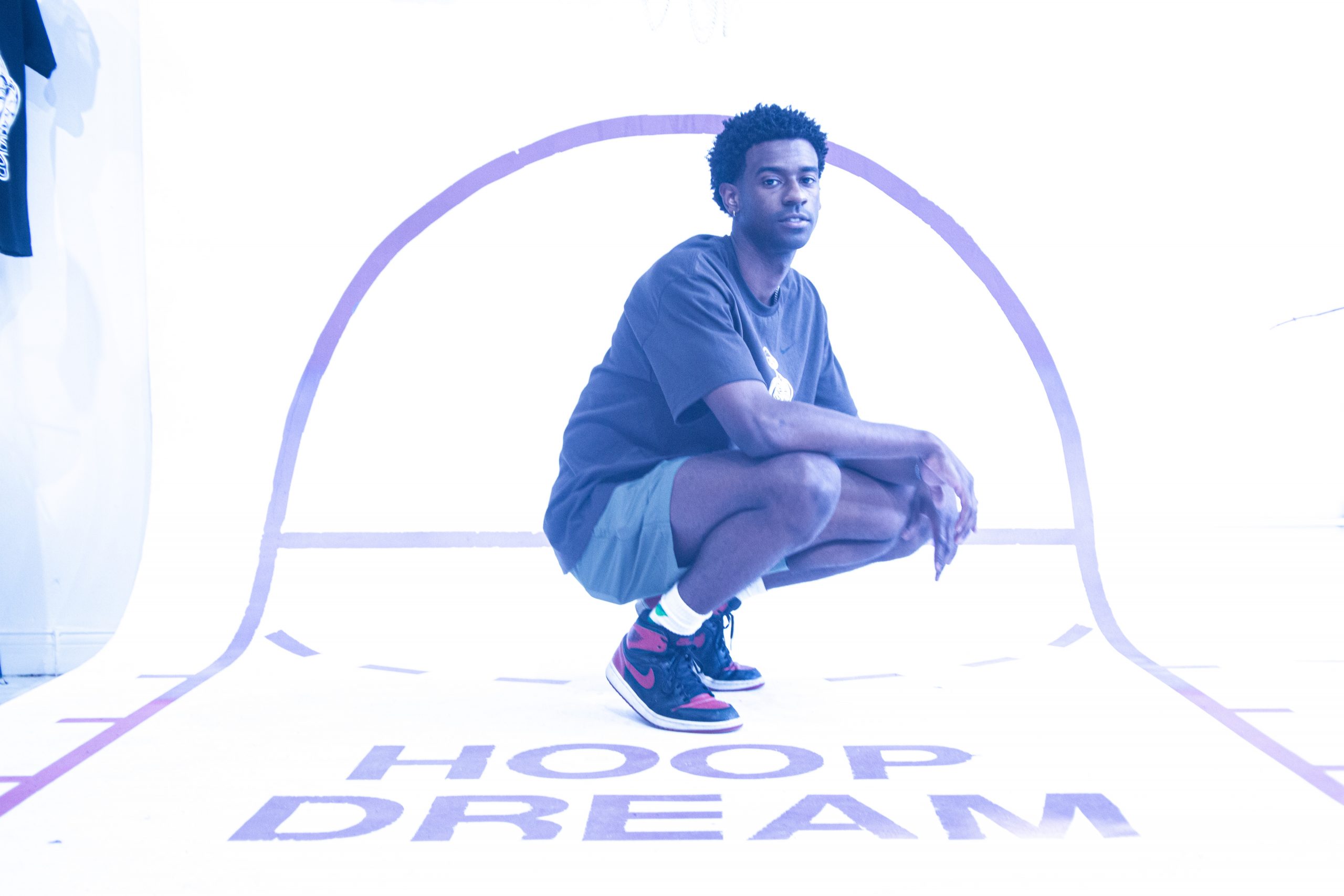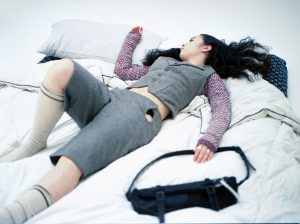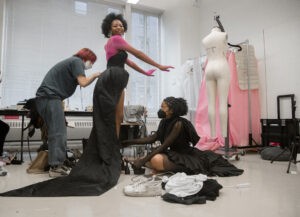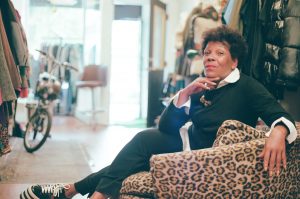Featured image: Jarrett Ellis, founder of hoopdreamstudios, in a pop-up at Congruent Space. Ellis is crouching down on a basketball court design that says “HOOP DREAM”. Photo by Dally Dew Drop.
It’s late July in Chicago. Summer solstice has long since passed, the mask mandate has seemingly dissolved, and the in-person event has risen again from the ashes of lockdown. In a sudden lurch, a fantastical standard has been set: people with access and ability to be out and about will be out and about. Experiences will be had, and they will be exciting and valuable and make up for all the “lost” time of the pandemic. (Nevermind that the pandemic isn’t, indeed, “over,” or that “lockdown” never ends for people inside prison walls or otherwise forcibly disposed into ever-proliferating forms of criminalized life). This particular historical moment is being positioned by retailers and other state agents as an “out of the shadows and into the light” moment that celebrates an ostensible “return to normal” — an “after” crisis that urges people to exhale and open their wallets again. All is well. Right?
For smaller makers and artists in Chicago and other U.S. cities, pre-pandemic income streams like temporary pop-up markets that rely on in-person shopping have become possible again. Many Chicago-based fashion designers, jewelry makers, bakers, and other artists are showing up at events day after day, weekend after weekend, in a bid to make up for gigs denied during periods with heavier restrictions. The pop-up shop is one element of a diverse set of pop-up practices that have become increasingly popular over the past decade in the global north, with creative start-ups and global brands like Nike alike relying on pop-ups as a marketing technique that offers consumers the promise of scarcity/elusive “cool” as a proxy for value. As a term, pop-up refers to “places that occupy a site for an intentionally temporary amount of time.” A pop-up can be a restaurant, bar, shop, cinema, or arts event, and has even expanded its reach in recent years to offer “pop-up” services like social housing and legal advice clinics where funding has been cut. As these diverse array of practices demonstrate, the pop-up locates itself within particular economic and political contexts and is mobilized by a variety of actors with very different goals. A typical pop-up sale in Chicago is a broad term but means a small scale event run out of an existing space like a brick-and-mortar retail shop, artist studio, gallery, roof, or backyard. Someone with clout who runs the space invites emerging designers or vintage sellers to vend their wares at the space for a night or a few weeks, often alongside DJ sets, flash tattoo sales, or other exclusive offerings. The lineage of the explosive popularity of the pop-up in recent years can be traced in large part to the 2008 economic crisis, where pop-ups became “a cheap, fast response to the “blight” of empty properties, and stimulus for regeneration during recession.” Besides offering a way to convert vacant or “underused” city real estate into value, the pop-up has asserted itself as the perfect solution to the manufactured death of more permanent, artist-run locations for independent artists and smaller-scale makers to share their work.
As writer and artist S. Nicole Lane previously noted in an article on the lifespan of Chicago’s artist-run spaces, the pop-up has become “a nomadic approach to navigat[ing]” the changing political and economic conditions of the city. Chicago’s own AMFM — Ciera McKissick’s critically important, decades-long arts and nightlife project — became a pop-up again in 2018 after being kicked out of its two year long stint as a brick and mortar in Pilsen due to “racial tensions,” (i.e. too many Black and brown people coming out to events). AMFM spent two years in their Pilsen space, providing studio space and mentorship for 10 resident artists and hosting over 200 events including large conceptual art shows such as the denim-oriented Indigo Nation, monthly showcases such as The Jazz Show, and gallery shows for emerging artists. AMFM had a welcoming, community-oriented feeling that they cultivated through their drop-in creative classes taught by working artists, their residency program, and their co-working space. The loss of AMFM’s permanent space in Pilsen felt particularly jarring as other more institutional-feeling DIY venues like the Dojo also shuttered, along with their norms and possibilities. Why was the most prominent emerging event space for queer, trans, and Black and brown artists — run by a queer Black femme — closing? Where else would those types of politicized imaginaries be made possible in Chicago? Once AMFM closed, it was forced to reinterpret itself within “partnerships” in order to gain space and revenue — i.e. within the context and existing norms of companies and institutions such as RedBull, SAIC, and the Chicago Parks. Whatever creative control and foundation laid by McKissick and her team while running their own space was cut into new shapes by those with more capital. In this way, pop-ups can thus serve to deflate the radical potential of permanent artist-run spaces like AMFM by “normali[zing] the idea that some claims to space are provisional and temporary, undermining the need for long-term resources in those sectors, and glorifying precarious situations.”
During times of recession and austerity, the “pop-up emerges as an exemplary, agile urbanism capable of extracting latent value from temporarily disused sites.” Pop-ups, in inhabiting “wasted” space-time, signal “the materialization of a capitalist fantasy of expansionary and nomadic drives” which, instead of increasing the capacities of socially-oriented artists to make enough money to live, may actually serve to solidify capitalist dominance of land use and decrease the frictional glitching of spaces that capital currently deems “wasted.” This is not at all to say that McKissick’s pop-ups are inherently non-radical in and of themselves; what I’m pointing to is the ways in which the drive towards pop-ups as the only or most ideal form for creatives to make offerings smooths over and attempts to disappear the tensions and violences of existing social infrastructure and investments. I don’t want RedBull or the School of the Art Institute of Chicago to be in charge of Chicago art. I want Ciera McKissick to be able to have a permanent space for as long as she wants it and for her to be able to do whatever she wants with it. I want her to be invested in for years at a time endlessly—a Universal Basic Income for the arts. Yet when pop-ups become normativized and valorized as sexy, flexible, and even preferable ways for artists to “scam the system,” other methodologies for collective provisioning fade into the background.
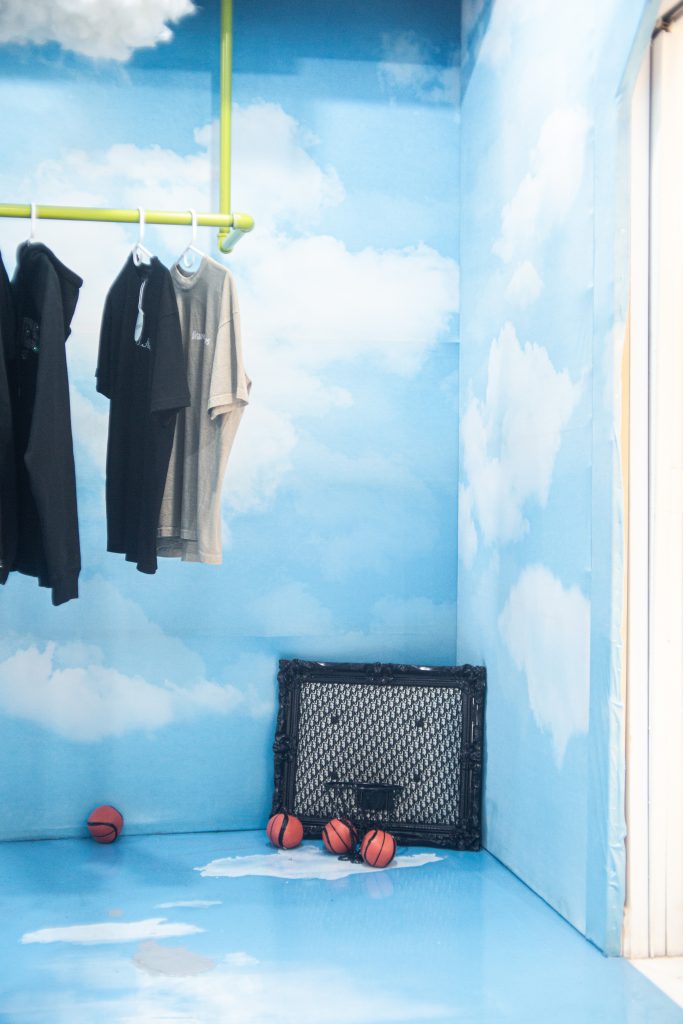
I’m not against the pop-up, but I don’t want the pop-up to stand in for what we really want. As the late Lauren Berlant challenged, “What if we gave up on the idea that we had to earn our life?” What might become possible if we looked at the core needs we are attempting to fill through the space of the pop-up — gathering in community, welcoming and affirming each other, sharing our art and creative expression, supporting each other’s practices and needs, having enough to eat, refusing to support Amazon, meeting cuties, etc., — and asked what other ways we could provision each other? As Berlant asks, what if we could “get the state to give up its hoarded wealth” instead of running ourselves into the ground doing pop-up after pop-up, thinking we are individually responsible for taking on the risks and precarity of generating a livable economy? What if we gave up the idea that we, as individuals, can game the system? What if, as Berlant asks, we gave up the fantasy that “the entrepreneurial subject is freer, somehow, than a subject whose state is providing resources to everyone. The idea that self exploitation is freedom.”? What else would become possible?
I know experiments are happening in collective provisioning that demand political and economic otherwises. But what about experiments that focus on fashion as an entrance point to abrading the imperial core? The empire itself is taking Fanon and Malcolm X’s “by any means necessary” assertion quite seriously and doesn’t consider any tactic to be too silly or mundane. I’m thinking, here, about the post 9-11 collaboration between Anna Wintour and George Bush called Fashion for America: Shop to Show Your Support. As a political, economic, and sartorial campaign, Fashion For America bugled that the “freedom to shop is one of the fundamental liberties [that] terrorists want to deprive us of.” Given COVID-19’s positioning as a similar threat to American freedoms (with the ultimate freedom being the freedom to spend), it makes sense that this moment would be seen as an order-restoring moment in which all freedom-lovers can and should come together to shop our assertion that the “threat” is over. What makes less sense is that people who conceive of themselves as against the project of the U.S. empire (i.e. the people that pop-ups are targeted to) would be authorizing the legacy of these campaigns by engaging in a “return to normal” politics that centers fashion consumerism. Since 9-11, Minh-Ha T. Pham argues, campaigns for fashion consumerism such as Fashion For America have relied on a construction of fashion that “enacts multiple neoliberal freedoms, including the freedom to consume and, connected to that, the freedoms of self-expression and self-determination.” Pham lays out how, since 9-11 particularly, an “ethical sartorial politics” has been manufactured and mobilized such that fashion has become a primary way to access “a multiplicity of democratic rights.”
I’m interested in the ways in which people, like me, who would never authorize George Bush or Anna Wintour are nevertheless living in the wake of this duo’s sartorial policies. What is happening such that people who don’t see themselves within the mainstream of consumption are engaged with tactics that have been strategically deployed to expand the reach of the U.S. empire? What is so lodged within our bodies that we would participate in tactics that may blunt our collective imaginations about what it is that we really want to be doing with our time on earth? I’m wrestling with what might be living in me on a cellular level that would make me unquestioningly want to go to a pop-up even if that pop-up doesn’t align with any of my stated politics and actually entrenches ideas of rights and freedoms that I explicitly don’t fuck with. What am I buying into that I can’t give up on?
I argue that the “return to normal” of conspicuous consumption at pop-ups relies on a notion of “dignity being restored” to “all” of “us.” In terms of thinking about the ways in which fashion is sutured to this idea of what is inherent to being human and worthy of saving, Mimi Thi Nguyen has shown that “beauty becomes a human right through the traditional concept of dignity.” Beauty and fashion become ways for the state to ensure that their project is seen as one of ensuring dignity for people they deem as needing saving. This tactic has proven successful because, “in current usage, dignity is held in high esteem and becomes the source of indignant defense of the subject and resistance to the questioning of its boundaries.” Ranjana Khanna’s 2008 essay, Indignity, tracks the history of the law and of the U.S. imperium’s use of “dignity,” which is commonly defined as being worthy or having merit, honor, or recognition. Dignity has come to “characterize an intrinsic value of the human, sometimes commanded (as in the command to be treated with dignity), sometimes given (to have dignity or worthiness restored).” Old white men like Cicero used the term to distinguish man from animal, arguing that “sensual pleasure is wholly unworthy of the dignity of the human race.” In 1785, Kant further refined this definition of dignity as part of individual autonomy or autonomous will such that self-legislating subjecthood becomes possible, and even Arendt saw dignity as the essential quality of Man, which made the right to have rights within a polity possible. By 1948 in the U.N.’s Universal Declaration of Human Rights, Khanna shows us, “the foundation of all human rights work was hallowed as ‘dignity,’” with the Declaration arguing, for instance, that “recognition of the inherent dignity, and of the equal and inalienable rights of all members of the human family is the foundation of freedom, justice, and peace in the world.”
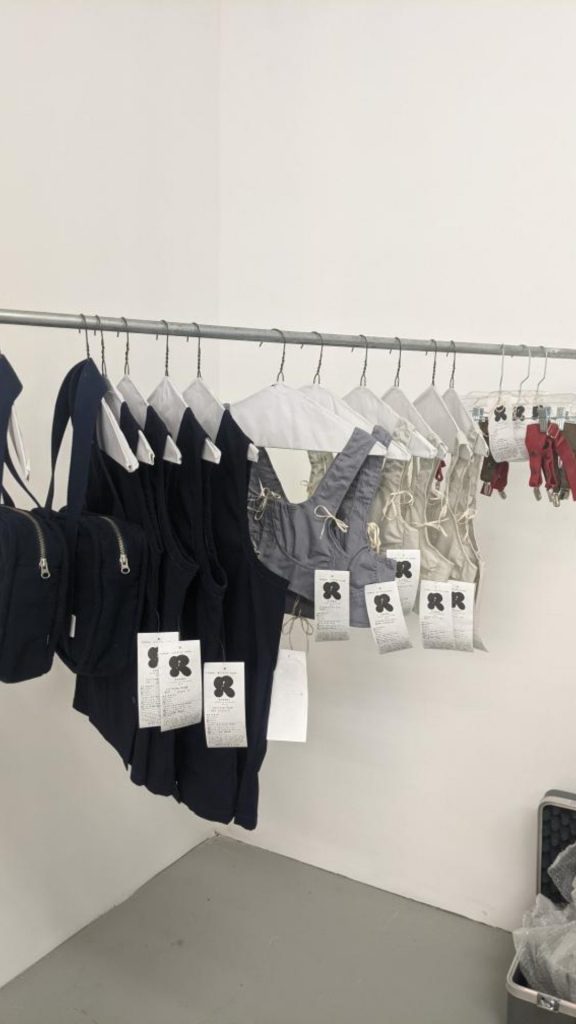
Yet as Nguyen reminds us, for “some of us there has never been unchallenged membership in the category of the human” to return to, “let alone an expectation of wholeness or dignity. And although it is understood as the foundation of all human rights, dignity is unstable, it can go missing and be restored.” The project of restoring some people’s dignity is fundamentally about power because “dignity is implicitly maintained through wealth and predicated on the poverty of some.” Beauty and fashion are seen as fundamental to the project of dignity and are thus mobilized and constructed by the state in very specific ways in order to manage crises. The burqa, for instance, became a metonym for anti-freedom whose wearers needed to be saved from “oppression,” thereby “justifying” the U.S. invasion of Afghanistan. As Nguyen makes clear, “questions about how dignity might be restored are important to how this restoration, in turn, might be informed by taxonomies of humanness and technologies of power.”
I see the call to return to normal in this moment as a demand to restore the public’s lost dignity. Inherent to that demand is a push to “reclaim” our uniquely democratic right to self expression and self determination (our “freedom to shop” and express ourselves through fashion). Yet these “freedoms” have always hinged on a category of the self and a category of the human that is amenable to the state itself. It is actually not acceptable to “express yourself” to the point of puncturing its ongoingness, as we can see in the case of the hoodie, which deems some bodies criminally Other. As such, Nguyen notes, “in its neoliberal mode beauty moves easily into forms of governmentality, guiding an individual to become recognizably human to state power.” At the pop-up, we navigate and negotiate beauty and fashion in order to prove our humanness after a crisis. The pop-up becomes the site in which the individual is called upon to “esteem herself, to maintain her own dignity, against dehumanization.” This is a contested zone where some people police the threshold that others attempt to enter. The stakes are high. At the function last month that was created to raise funds for a non-Black person’s gender transition fund, the $5/person RSVP was sent back to a Black community member via Cashapp with the message “RSVP CLOSED I AM SENDING THIS BACK AND YOU NEED TO PAY $10 EACH AT THE DOOR.” Given that the deadline to RSVP wasn’t on the flyer and that an Instagram story had been circulating offering reduced entrance for trans people, the community member sent the $5 back with the message, “I’m a Black nonbinary person who wants to support you in your [gender transition] fund, but this is what I have to offer today.” Said event organizer rejected the payment again with the message “This is ridiculous,” found the community member on Instagram, messaged them to question why they were “fighting them,” and questioned this person’s ethics. After extensive back and forth where the non-Black event organizer called the Black community member aggressive and anti-Black (??), they eventually apologized and asked the community member to come to the event. The community member didn’t respond and didn’t show up, given the ways that they had already had to fight for their presence to be recognized as not inherently bad or aggressive. A vendor later reported that the space was predominantly white, meaning that most of the people who were able to get in and pay their $5 entrance fee were white. Yet the name of the event used the term “my bag” to connote the need for funds and to cheekily reference current slang around someone’s unique preferences, desires, and style. “My bag” is a term that is used primarily by Black people and that traces its lineage to Black jazz musicians in the 1960s as well as to Jimi Hendrix. Pop-up spaces like this fundraiser that are ostensibly for “people of color” and their joy and pleasure — and that name themselves explicitly within those legacies — continue to enact violence that reveals that some people are seen as inherently with-dignity and some are not. That some people have to fight for their dignity to be restored so that they could come to the event, even if those people are not interested in the predominant notion of the human that we are working with. As Sylvia Wynter argues,
“We presently live in a moment where the human is understood as a purely biological mechanism that is subordinated to a teleological economic script that governs our global well-being/ill-being—a script, therefore, whose macro-origin story calcifies the hero figure of homo oeconomicus who practices, indeed normalizes, accumulation in the name of (economic) freedom. Capital is thus projected as the indispensable, empirical, and metaphysical source of all human life, thus semantically activating the neurochemistry of our brain’s opiate reward/punishment system to act accordingly!”
Through the pop-up, I see us living into Wynter’s idea of homo oeconomicus — the human as consumer within a free market, the human as “the virtuous breadwinner, the stable job holder, the taxpayer, the savvy investor, the master of natural scarcity.” As I witness the rush of certain people to participate in public displays of consumerism, I am reminded of Pham’s argument that conspicuous consumption “serve[s] a number of political functions” in service of a neoliberal project of “physical and political liberation.” Coming out to shop in-person “metaphorically inaugurat[es] a process of political visibility,” that comes to stand in for personhood itself. The methods that disabled organizers offered to us all on how to love each other better are shed almost instantly at the events that I’ve seen circulating, from pop-up vintage shops to club events. Mutual aid groups that formed during the peak number of COVID-19 deaths in the U.S. imperial core remind us that these groups have the same amount of and need for requests for aid, but much lower donations are coming in to support those requests. The willingness of my neighbors and I to go on rent strike is replaced by an isolated sense of resignation every first of the month. Flyers with information about where you can get free lunch (is it just for the pandemic?) are replaced by flyers for in-person, presumably mask-free events with no accessibility information. The pop-up as a function is advertised typically through Instagram stories and word of mouth, with the tight circuit of its sending and the short notice itself performing a notion of who is in and who is out.
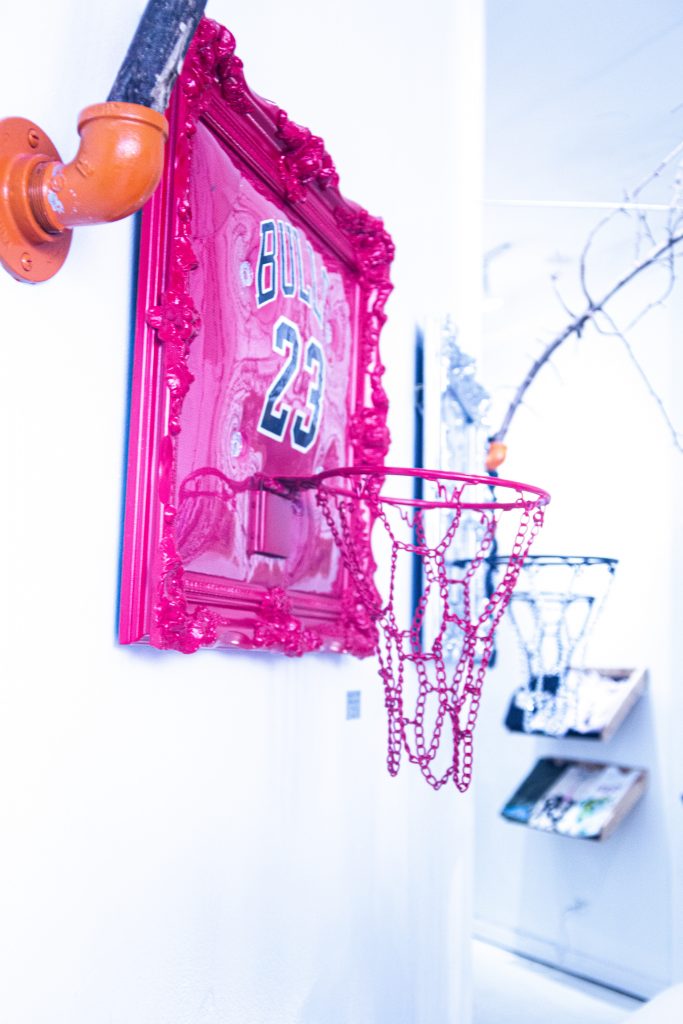
The allure of each in-person event crackles and spins as it’s sent around Instagram and through group chats. The speed and glamour associated with each function operates with the force of myth. Organizers seem overwhelmed by the interest in their events, with lines out the door and hundreds of people willing to shell out $15 for rooftop raves with one-non-disabled-person-at-a-time fire escape entrances (and exits, when the cops kick everyone out). In West Town last week, there was a line down the block to get into Congruent Space, a retail shop that creates conceptual installations for its rapidfire set of pop-ups featuring local and international artists. Preme, creative director at Congruent Space, is practiced in tapping into people’s appetite for the “real.” The architecture, decor, and product display are all constructed to shift the feeling of the space from a simple site of consumption to an experience in and of itself. Everything is there for you to understand that this is decidedly not the mall. The work it takes to construct such experiences is something the team at Congruent Space is willing to do over and over again. For Chicago legend Joe Freshgoods’ “Beauty Supply” takeover, the team hand dyed two tons of sand to create indoor pink and green beaches to match the pink and green hoodies. For the pop-up I visited featuring Hoop Dreams Studio, the team built an indoor basketball court featuring one of Jarrett Ellis’ custom, one-of-a-kind hoops. Ellis has created hoops for the likes of Young Thug, K-Nunn, Meek Mill, and Snoop Dogg. His offerings within the context of Congruent seem like a perfect marketing strategy for meeting the needs of consumers who are looking for, according to a report by the Future Laboratory, “hubs of activity with rewards such as exclusive products, immersive experiences or lifestyle services.”
I loved getting a chance to talk to Ellis at the pop-up, where he outlined how valuable it’s been for him to create experiences for people where they can see, touch, and play with the designs. Hoop Dreams Studio cofounder Malik Luhvette talked about how important it is to “put people in an environment where they can reflect on their own life, find out what’s important to them, and express that in any way they would like.” There is something that feels potent to me in the need that the Future Laboratory is narrating in terms of immersive experiences. People want to live in a story, because we are stories. We want to be immersed, but I don’t think it’s as consumers. I think it’s to be immersed with each other as story-beings. The stakes of which, I learned from Sylvia Wynter, are quite high:
“What I’m putting forward as a challenge here, as a wager, is therefore that the human is, meta-Darwinianly, a hybrid being, both bios and logos […] if I am right, I cannot expect them to accept it easily. For our entire order of secular knowledge/truth, as it has to do with ourselves, is devastated if we are hybrid beings! If humans are conceptualized as hybrid beings, you can no longer classify human individuals, as well as human groups, as naturally selected (i.e., eugenic) and naturally dysselected (i.e., dysgenic) beings. This goes away. It is no longer meaningful. So I have to be realistic and say how can I expect people whose discipline is their identity to accept this hybrid model? When what they/we are being faced with is the total removal of their discipline as an autonomous field of inquiry? But then think of the dazzling creativity of the alternative challenge that would be opened up!”
What I’m saying is: the pop-up is not challenging the homo oeconomicus model of what it means to be human. I think we can do better, and I want to do better with you. I want to re-experience ourselves and re-decide, collectively, how we want to show up for each other. How do we want to express, together, beyond the self-expression deemed acceptable to the project of the U.S. empire? How can we love each other enough that we can give up on the idea of dignity that holds together our idea of the human? If at the heart of it all is, “a gasp, a bleeding cut, a haptic involution, a self-touching encounter,” what then? How can we leap, while nourishing each other’s “strange, perverse, wild, indeterminate, and powerful” selves? Let us not re-settle into the pop-up.
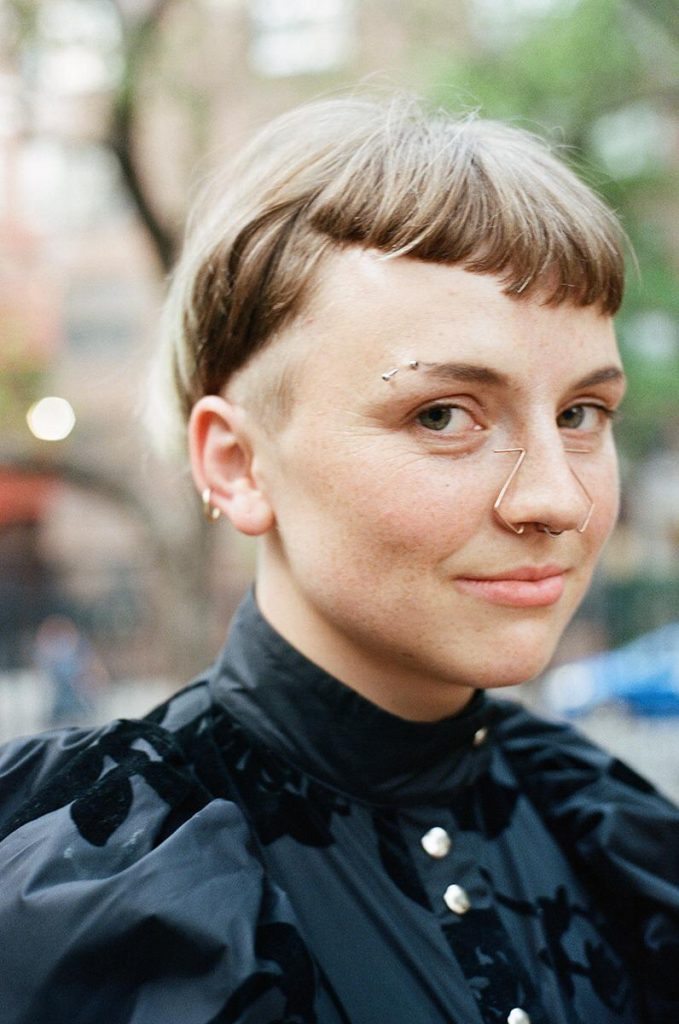
row särkelä is an organizer, artist, and white settler raised in tiwaland and living in zhigaagoong. in “fold unfold,” row addresses the seepages between fashion and social movement organizing, surfacing the work of designers and artists who shape and intervene in chicago’s vestiary landscapes. row considers taste to be a political project and investigates how design and dress unfold in relation to local forms of racial capitalism.
